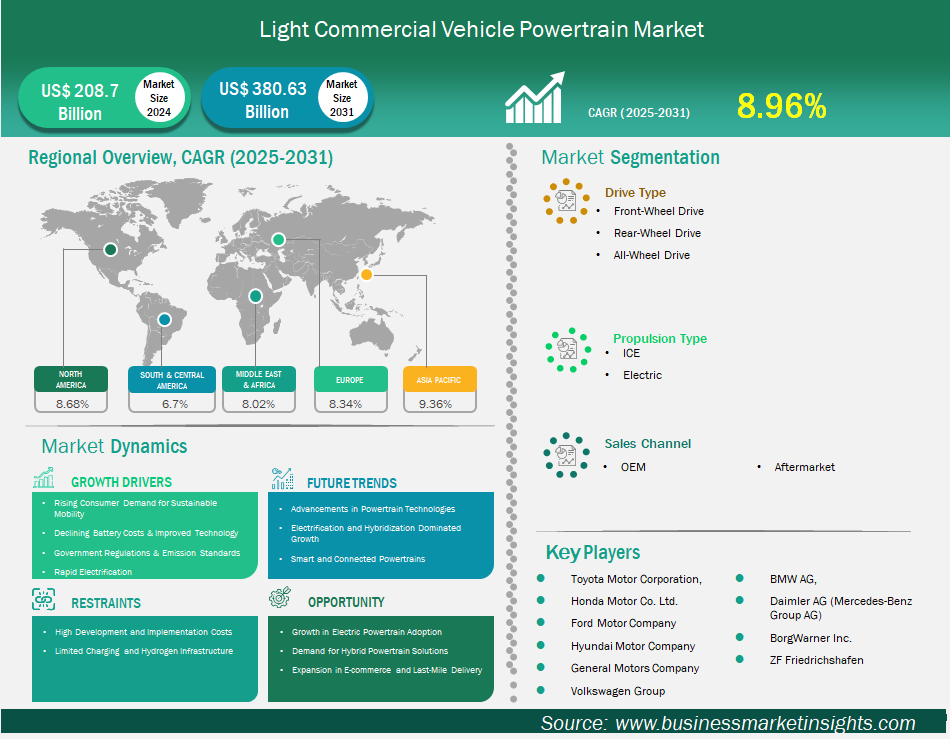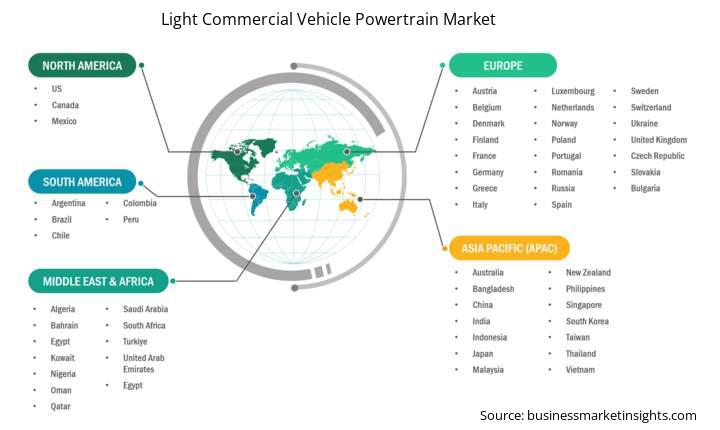Light Commercial Vehicle Powertrain Market Outlook (2021-2031)
No. of Pages: 200 | Report Code: BMIPUB00031703 | Category: Automotive and Transportation
No. of Pages: 200 | Report Code: BMIPUB00031703 | Category: Automotive and Transportation
The Light Commercial Vehicle powertrain market size is expected to reach US$ 380.63 billion by 2031 from US$ 208.7 billion in 2024. The market is estimated to record a CAGR of 8.96% from 2025 to 2031.
The light commercial vehicle (LCV) powertrain market is on a strong growth trajectory, propelled by surging demand for efficient logistics, rapid urbanization, and the global push for cleaner transportation solutions. The rapid expansion is being fueled by government incentives, the drive by fleet operators to reduce operational expenses, and continuous improvements in battery technology. In parallel, the market for powertrain sensors—critical components for both combustion and electric systems—is set to experience rapid growth, underscoring the growing technological sophistication of modern LCV powertrains.
Asia Pacific stands as the leading region in the global light commercial vehicle (LCV) powertrain market, expected to maintain its top position in market share. This dominance is driven by accelerating urbanization, the rapid expansion of e-commerce, and a strong demand for agile, efficient vehicles suited to crowded urban environments. The region’s growth is primarily propelled by China, India, and Japan.
Europe is experiencing strong momentum in electrification, with government regulations and sustainability targets accelerating the adoption of electric LCVs.
North America features a well-established LCV market, with consistent demand for both internal combustion engine and electric powertrains. Growth in the region is largely driven by the logistics and last-mile delivery industries, prompting OEMs to develop adaptable powertrain platforms that support both ICE and electric vehicle options

Key segments that contributed to the derivation of the Light Commercial Vehicle Powertrain market analysis are drive type, propulsion, sales channel, and geography.
The growing adoption of electric light commercial vehicles (eLCVs) is significantly boosting the market, driven by emissions regulations, government incentives, and the demand for greener urban delivery solutions. This compels fleet operators and manufacturers to widely embrace electric and hybrid vehicle technologies.
The booming e-commerce sector and the rise of last-mile delivery are driving the need for light commercial vehicles (LCVs) that are easy to manoeuvre, fuel-efficient, and economical. This, in turn, is accelerating advancements and adoption of new powertrains, especially in cities.
By drive type, Front-Wheel Drive (FWD), Rear-Wheel Drive (RWD), and All-Wheel Drive (AWD) – The global LCV market is projected for substantial growth, driven by factors like e-commerce expansion, last-mile delivery demands, and stringent emission regulations.
By propulsion type, ICE powertrains (gasoline and diesel) currently hold the largest market share in the overall LCV market. This is due to their established infrastructure (fueling stations), proven performance, cost-effectiveness, and high payload/towing capacities. Many commercial fleets still rely heavily on ICE LCVs for their long-standing reliability and widespread availability. The electric LCV (eLCV) market is experiencing phenomenal growth and is projected to be the fastest-growing segment.
By sales channel, the OEM channel, representing factory-fitted components and new vehicle sales, continues to dominate overall market value. Growth in the OEM channel is driven by OEM’s heavy investment and rapidly scaling the production of electric and hybrid LCVs. The Light Commercial Vehicle aftermarket, which includes replacement parts, accessories, maintenance, and upgrades, is also experiencing strong and sustained growth. Key growth drivers include an aging vehicle fleet, increased vehicle longevity, environmental awareness, customization trends, and the transition to electric vehicles.
By geography, Asia-Pacific leads the overall size and EV adoption, Europe demonstrating strong regulatory-driven electrification, North America rapidly embracing electric pickups and vans, and Latin America and MEA emerging as growing markets with increasing electrification potential. Asia-Pacific currently dominates the global LCV market and is also the leading region for electric LCVs, holding the largest market share in 2024. Countries like China, India, and Japan are experiencing explosive growth in e-commerce and last-mile delivery, creating immense demand for LCVs, particularly for urban logistics. The region often leans towards lighter LCVs (less than 3.5 tons), suitable for congested urban environments.
| Report Attribute | Details |
|---|---|
| Market size in 2024 | US$ 208.7 Billion |
| Market Size by 2031 | US$ 380.63 Billion |
| Global CAGR (2025 - 2031) | 8.96% |
| Historical Data | 2021-2023 |
| Forecast period | 2025-2031 |
| Segments Covered |
By Drive Type
|
| Regions and Countries Covered | North America
|
| Market leaders and key company profiles |
|
The "Light Commercial Vehicle Powertrain Market Outlook (2021–2031)" report provides a detailed analysis of the market covering below areas:

The geographical scope of the Light Commercial Vehicle Powertrain market report is divided into five regions: North America, Asia Pacific, Europe, Middle East & Africa, and South & Central America. The Light Commercial Vehicle Powertrain market in Asia Pacific is expected to grow significantly during the forecast period.
The Light Commercial Vehicle (LCV) powertrain market displays significant regional disparities driven by unique economic, regulatory, and logistical factors. Asia-Pacific currently leads the global LCV market in terms of both overall volume and electric LCV adoption, with China and India at the forefront due to booming e-commerce, rapid urbanization, and substantial government support for electrification. Europe is a major LCV market characterized by stringent emission regulations and robust government incentives, which are rapidly accelerating the shift from traditional diesel powertrains to electric and hybrid LCVs, especially for urban deliveries and meeting corporate sustainability goals. North America sees a strong demand for larger LCVs, particularly pickup trucks, and is actively pursuing fleet electrification with significant government initiatives aimed at boosting electric LCV adoption.
Meanwhile, South and Central America is an emerging market experiencing growth fueled by expanding e-commerce and increasing government interest in electromobility, with LCVs being the largest and fastest-growing segment in its electric commercial vehicle market. Finally, the Middle East & Africa (MEA) region, though currently dominated by ICE vehicles, is demonstrating growing ambition for electric LCV adoption, driven by economic diversification efforts and evolving government policies, making it a promising future growth area despite existing infrastructure challenges.
The Light Commercial Vehicle Powertrain market is evaluated by gathering qualitative and quantitative data post primary and secondary research, which includes important corporate publications, association data, and databases. A few of the key developments in the Light Commercial Vehicle Powertrain market are:
The Light Commercial Vehicle Powertrain Market is valued at US$ 208.7 Billion in 2024, it is projected to reach US$ 380.63 Billion by 2031.
As per our report Light Commercial Vehicle Powertrain Market, the market size is valued at US$ 208.7 Billion in 2024, projecting it to reach US$ 380.63 Billion by 2031. This translates to a CAGR of approximately 8.96% during the forecast period.
The Light Commercial Vehicle Powertrain Market report typically cover these key segments-
The historic period, base year, and forecast period can vary slightly depending on the specific market research report. However, for the Light Commercial Vehicle Powertrain Market report:
The Light Commercial Vehicle Powertrain Market is populated by several key players, each contributing to its growth and innovation. Some of the major players include:
The Light Commercial Vehicle Powertrain Market report is valuable for diverse stakeholders, including:
Essentially, anyone involved in or considering involvement in the Light Commercial Vehicle Powertrain Market value chain can benefit from the information contained in a comprehensive market report.